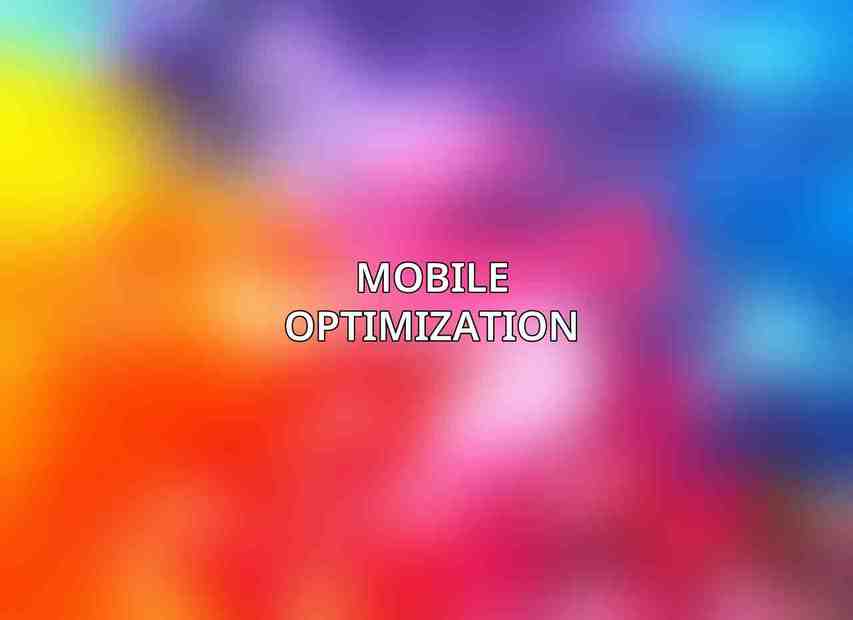core web vitals have become crucial for ensuring a seamless user experience and improving search engine rankings. it’s essential to optimize the key metrics that include largest contentful paint (lcp), First Input Delay (FID), and Cumulative Layout Shift (CLS).
Largest Contentful Paint (LCP):
- To enhance LCP, it is imperative to optimize image size and dimensions, thus reducing loading times.
- Implementing lazy loading for images and videos can significantly improve the overall loading speed of a webpage.
- Minification of CSS and JavaScript files helps in reducing file sizes and boosting loading performance.
First Input Delay (FID):
- Reducing JavaScript execution time by eliminating unnecessary scripts and optimizing critical scripts.
- Using event delegation to streamline event handling and reduce delays in user interactions.
- Minimizing DOM elements on a webpage to enhance responsiveness and reduce the delay in user input responsiveness.
Cumulative Layout Shift (CLS):
- Set fixed dimensions for images and videos to prevent sudden layout shifts during page rendering.
- Utilize CSS grid or flexbox layouts to maintain the structure of the page elements and avoid unexpected shifts.
- Avoid dynamically loading elements that might cause unexpected layout changes leading to poor user experience.
Site Architecture
For a website to rank efficiently in search engine results, a well-structured site architecture is indispensable. Explore further with Mobile SEO: The Key to Ranking in a Mobile-First World
Sitemap:
- Creating an XML sitemap containing all important pages to help search engines effectively crawl and index the website.
- Regularly updating and submitting the sitemap to search engines to ensure the inclusion of new content and changes.
- Ensuring that the sitemap includes all crucial pages and excludes unnecessary or duplicate content.
Robots.txt:
- Blocking access to directories that contain irrelevant or sensitive information to prevent them from being indexed by search engines.
- Specifying which pages or directories should not be crawled through directives in the robots.txt file.
- Properly structuring the robots.txt file to guide search engine crawlers on the website’s content and indexing instructions.
URL Structure: You can find more information on SSL Certificates and Their Impact on SEO
- Using descriptive and keyword-rich URLs that reflect the content of the page to enhance search engine visibility.
- Keeping URLs concise and readable for users and search engines to easily understand the page content.
- Avoiding the use of parameters in URLs whenever possible to maintain a clean and user-friendly URL structure.
Canonicalization
canonicalization plays a vital role in resolving duplicate content issues and enhancing the authority of the preferred version.
- Canonical Tags:
- Using canonical tags to specify the preferred version of duplicate content and avoid diluting SEO value across multiple versions.
- Avoiding the use of multiple rel=”canonical” tags on a single page to prevent conflicting directives.
- 301 Redirects:
- Redirecting old or unwanted URLs to the preferred version through 301 redirects to consolidate link equity and maintain SEO value.
- Ensuring that all redirects, especially during migrations or content changes, are implemented with HTTPS to maintain security and SEO integrity.
- URL Parameters:
- Utilizing canonical tags to handle URL parameters effectively by indicating the main URL version for indexing.
- Considering the use of query strings for dynamic content while ensuring that they are properly managed to avoid indexing issues.
Crawlability and Indexing
Crawlability and Indexing are pivotal for search engines to discover and rank website content accurately.
- Crawling Budget:
- Optimizing the website structure to reduce crawling time and ensure that search engine bots can efficiently navigate through the site.
- Guiding search engine crawlers with pagination and sitemaps to prioritize crawling of important pages and content.
- Page Speed:
- Enhancing website loading speed by implementing strategies mentioned in Core Web Vitals optimization for improved user experience and SEO rankings.
- Considering the usage of Content Delivery Networks (CDNs) to distribute content and optimize loading times across global locations.
- Indexability:
- Verifying that all significant website pages are indexed by search engines and identifying and resolving any indexing issues.
- Using the Robot Exclusion Protocol (robots.txt) to control search engine access to specific parts of the website.
- Monitoring and analyzing the indexing status through tools like Google Search Console to rectify any crawling or indexing discrepancies.
Mobile Optimization

With the surge in mobile usage, Mobile Optimization has become indispensable for SEO success and user engagement.
- Responsive Design:
- Developing a responsive website that adapts seamlessly to various screen sizes and devices for optimal user experience.
- Employing CSS media queries and flexible design elements to create a mobile-friendly layout.
- Accelerated Mobile Pages (AMP):
- Implementing AMP for rapid mobile page loading, providing users with instant access to content.
- Ensuring that AMP pages comply with Google’s stringent guidelines for optimal performance and visibility.
- Mobile Usability Test:
- Conducting thorough usability tests on diverse mobile devices to identify and rectify any layout or functional issues hindering user experience.
- Prioritizing mobile optimization to cater to the increasing number of users accessing websites via mobile devices.
Security

Security is not only vital for safeguarding user data but also impacts website rankings and trustworthiness in search engines. Find more on Speed Up Your Site: SEO Speed Enhancement Techniques
- HTTPS:
- Employing SSL certificates to encrypt website traffic and signal secure connections to users and search engines.
- Ensuring that HTTPS is implemented across all website pages to enhance security and trustworthiness.
- Vulnerability Scanning:
- Regularly scanning the website for potential security vulnerabilities using robust security tools and promptly addressing any identified issues.
- Maintaining proactive security measures to protect the website and user data from cyber threats.
- Anti-Malware Software:
- Installing reputable anti-malware software to prevent and detect malware infections, safeguarding the website from malicious attacks and vulnerabilities.
Other Technical Considerations
Apart from the core aspects of technical SEO, certain additional considerations contribute to the overall performance and visibility of a website.
- Structured Data:
- Implementing structured data markup, such as Schema.org, to provide search engines with detailed information about content and enhance visibility in rich snippets.
- Image Optimization:
- Optimizing images by using descriptive file names and ALT tags to improve accessibility and SEO.
- Compressing images without compromising quality to enhance page loading speed and user experience.
- Accessibility:
- Ensuring that the website is accessible to users with disabilities by adhering to Web Content Accessibility Guidelines (WCAG 2.1) standards.
- Implementing features like alternative text for images and keyboard navigation for improved accessibility and user engagement.
By meticulously following this Ultimate Technical SEO Checklist for 2024, website owners and digital marketers can enhance their online visibility, user experience, and search engine rankings effectively. Embracing the latest trends and best practices in technical SEO is crucial for staying ahead in the dynamic digital world.
To learn more about technical SEO practices for 2024, refer to authoritative sources like Google’s Webmaster Guidelines and SEO resources from industry experts. You can find more information on How to Optimize Your Site Structure for SEO
Frequently Asked Questions
What is technical SEO?
Technical SEO refers to the process of optimizing a website’s infrastructure to improve its search engine visibility and crawlability.
Why is technical SEO important?
Technical SEO plays a crucial role in ensuring that search engines can properly index and rank your website, leading to increased organic traffic.
What are some key elements of technical SEO?
Some key elements of technical SEO include website speed optimization, mobile-friendliness, schema markup implementation, and proper URL structure.
How often should technical SEO be updated?
Technical SEO should be continuously monitored and updated to keep up with changing search engine algorithms and trends. It is advisable to perform regular audits and updates at least quarterly.
What are some tools that can help with technical SEO?
Some popular tools for technical SEO include Google Search Console, Screaming Frog, SEMrush, Ahrefs, and Moz Pro. These tools can help analyze website performance, identify issues, and track improvements.

